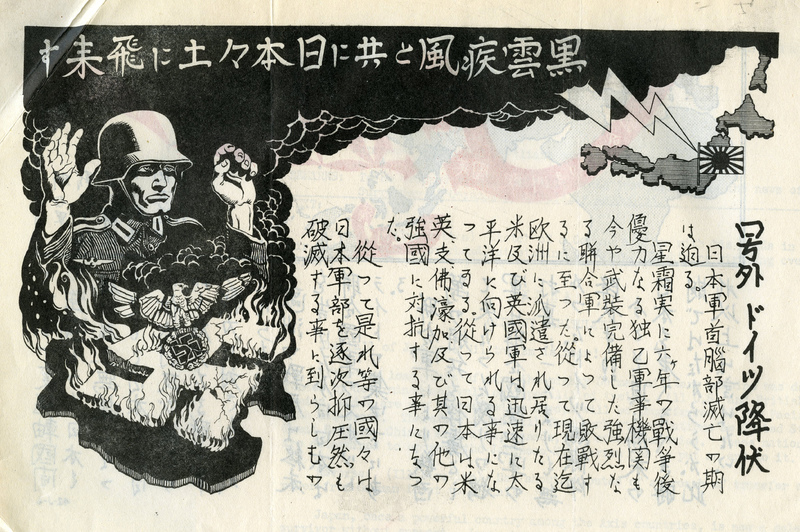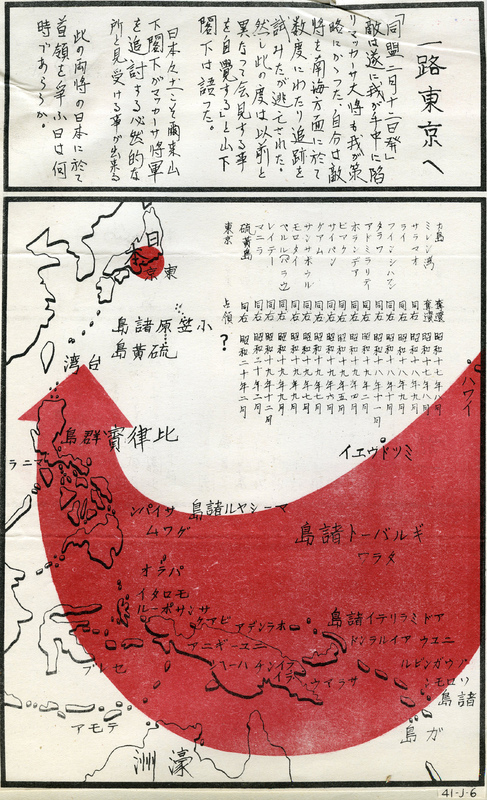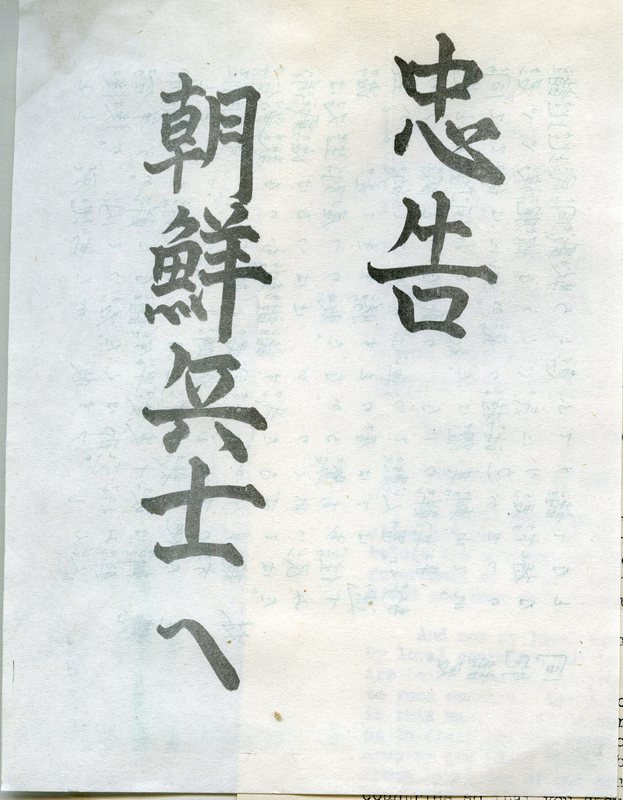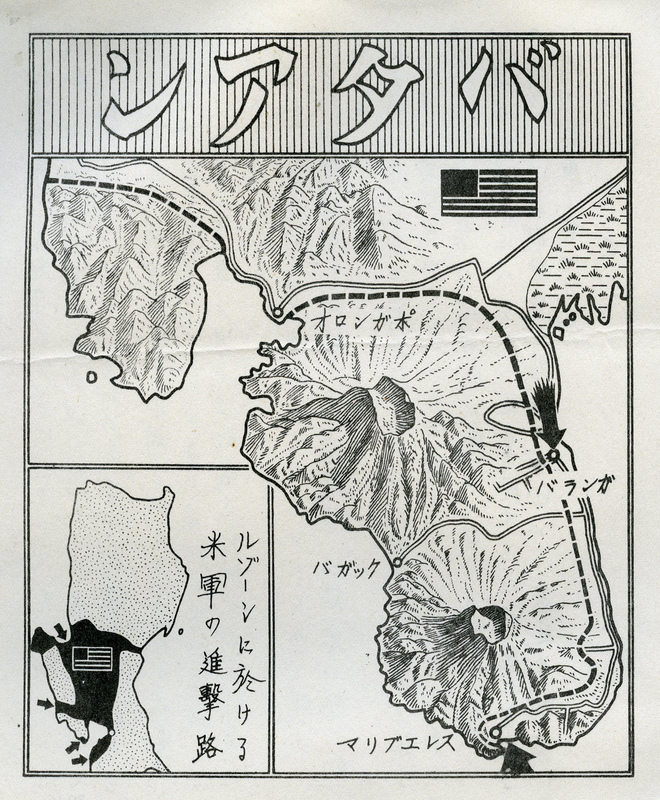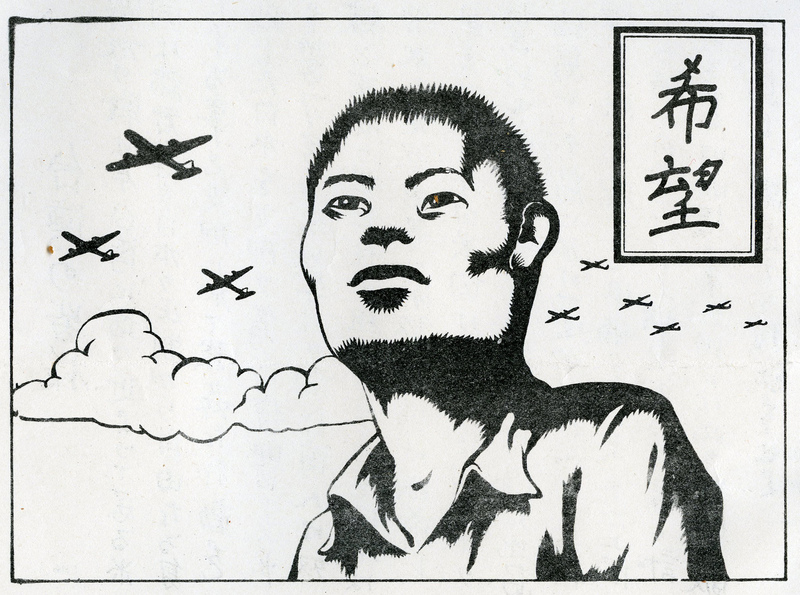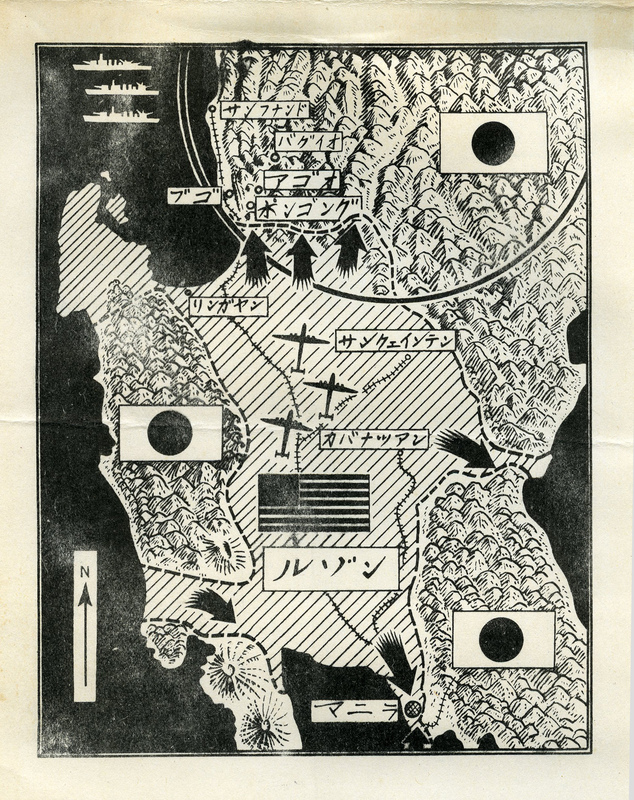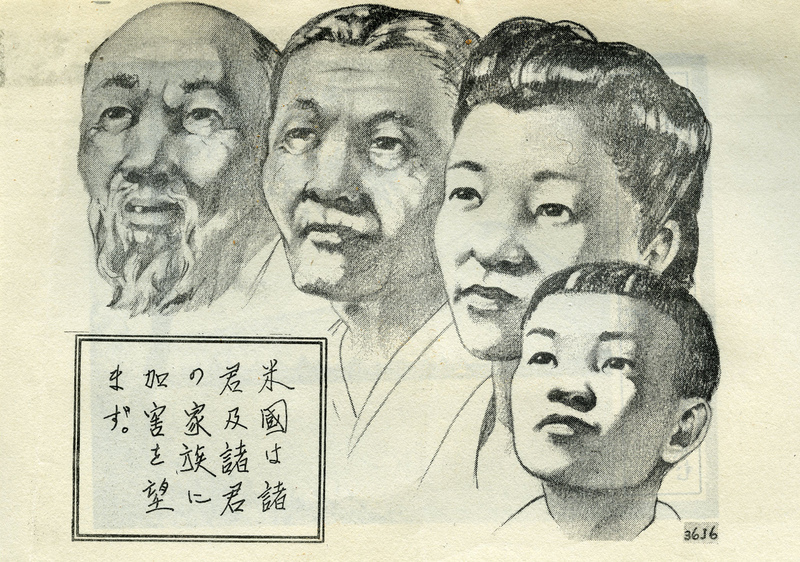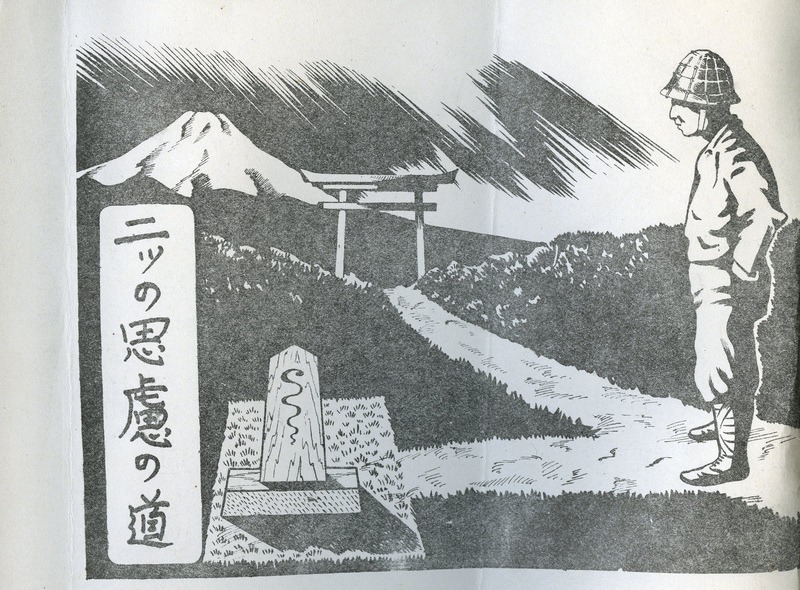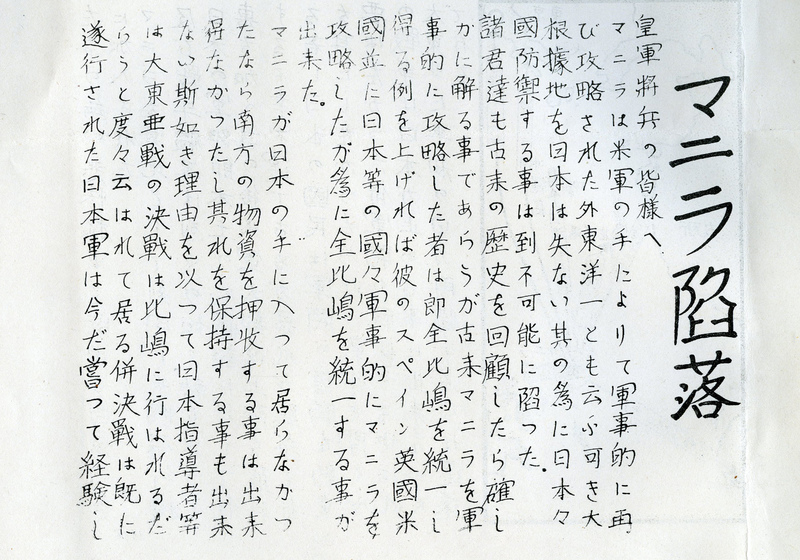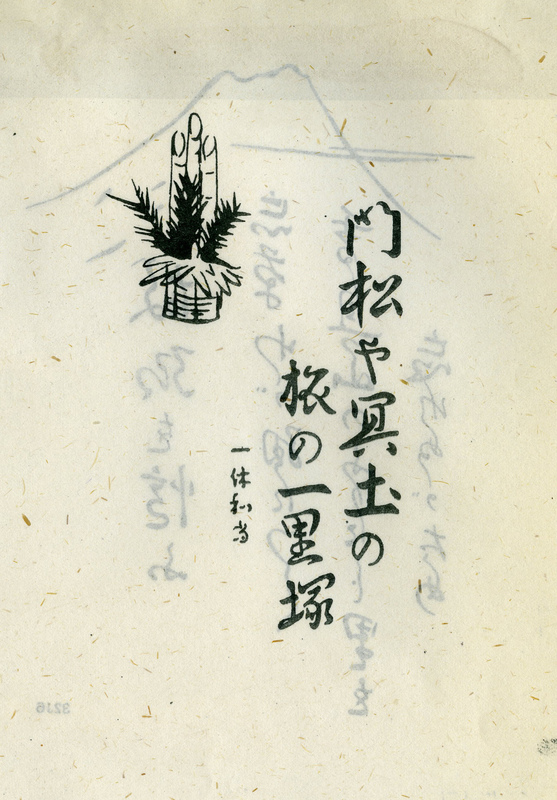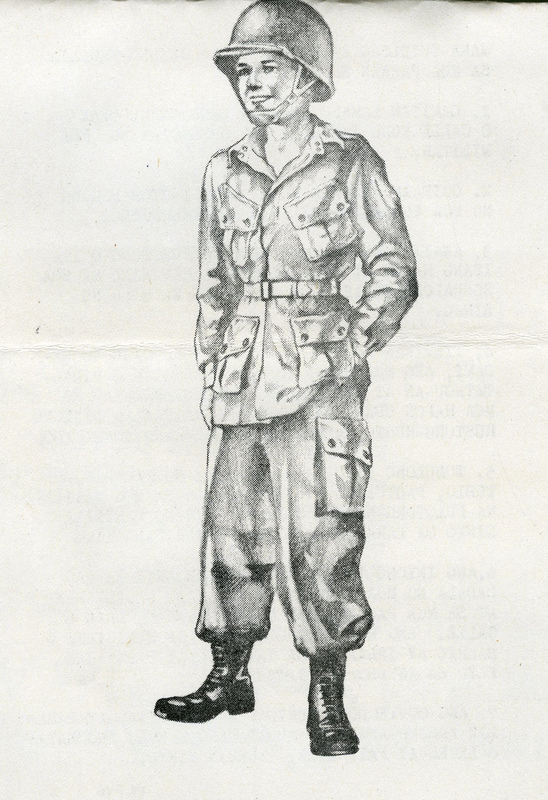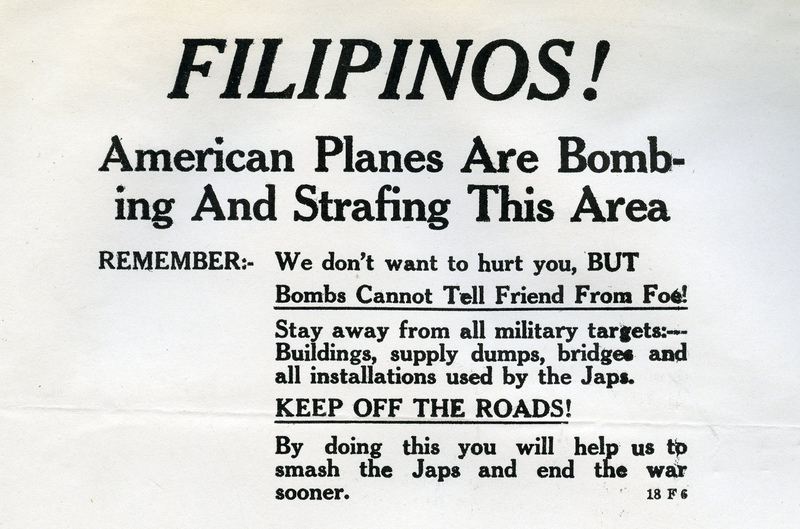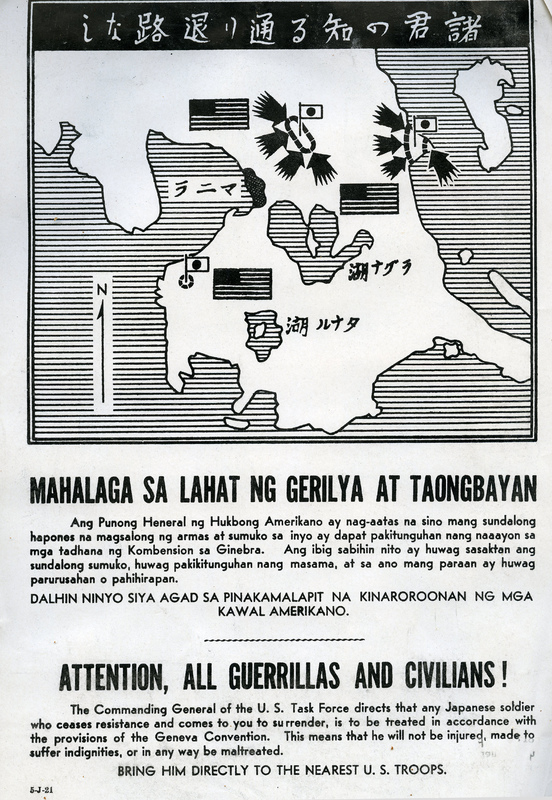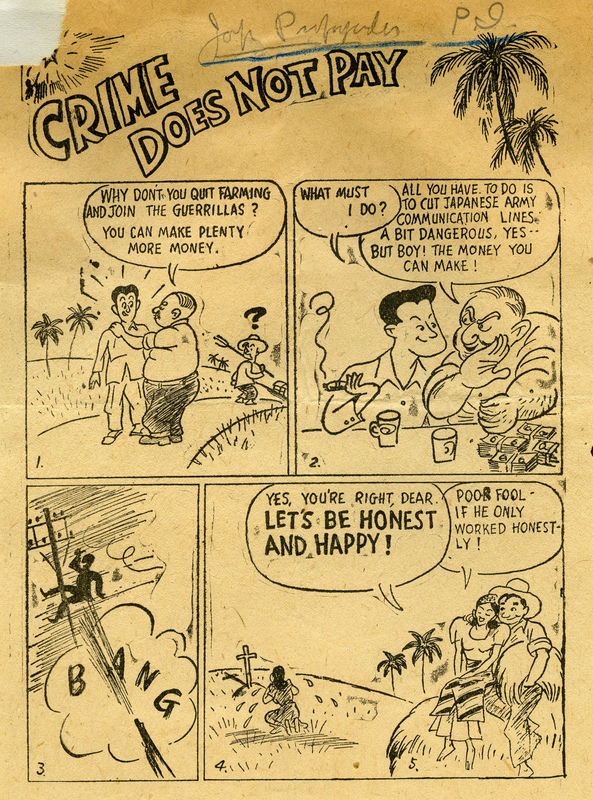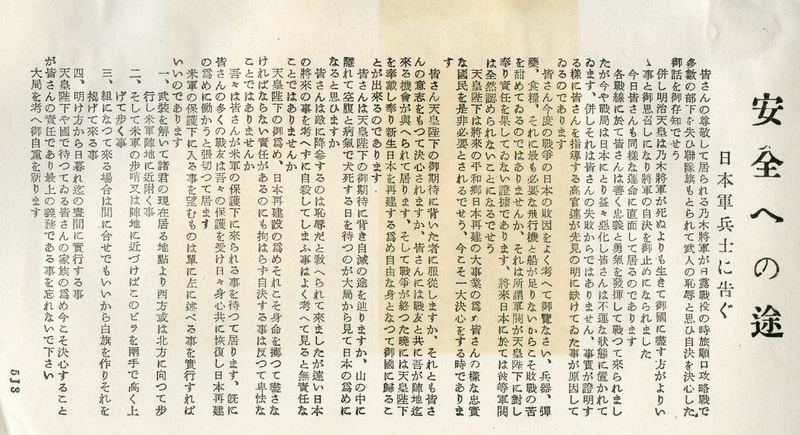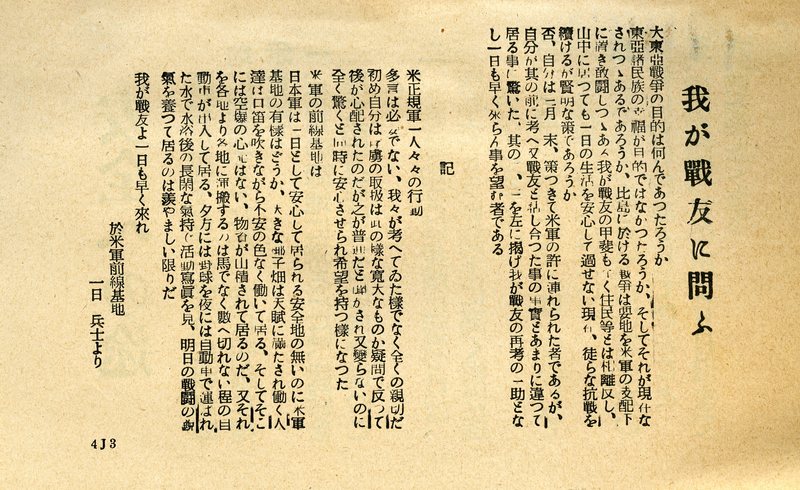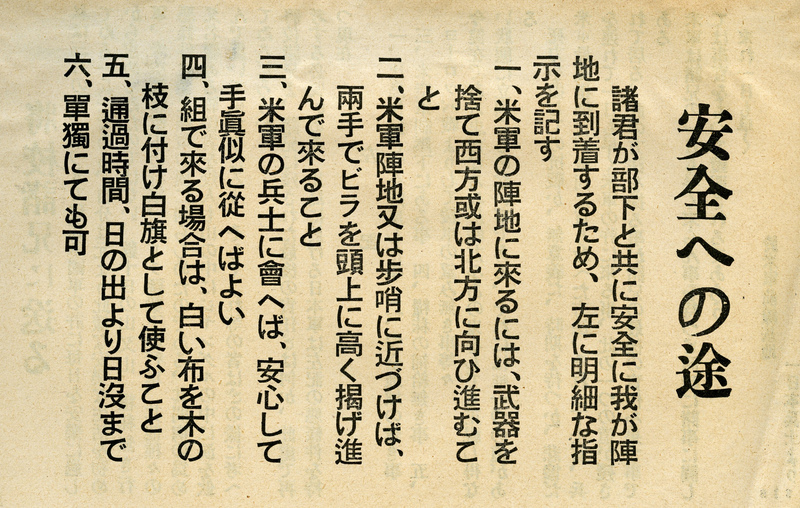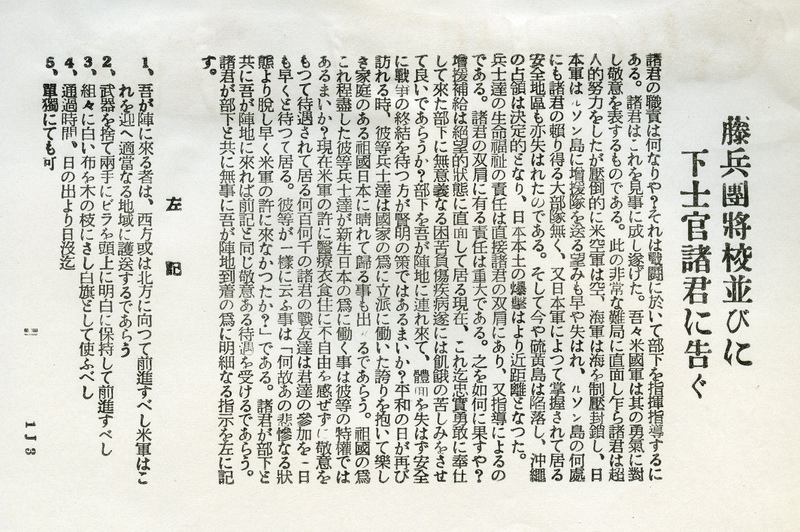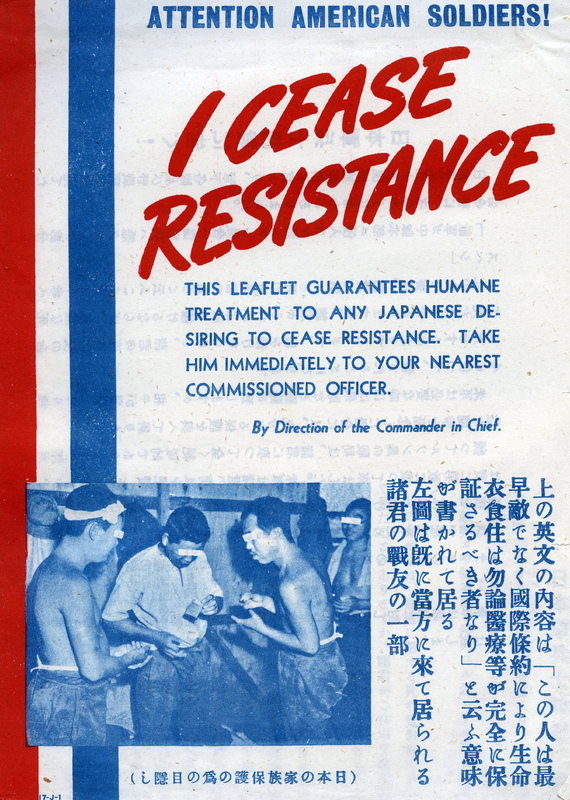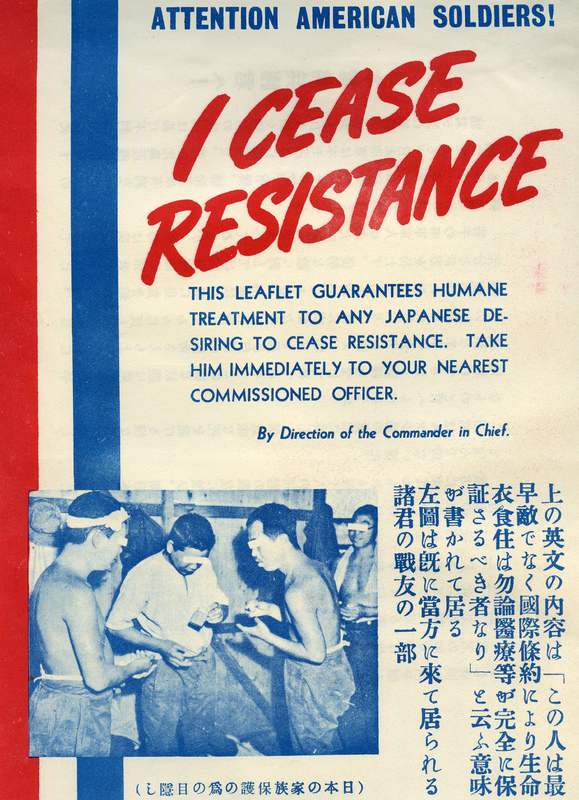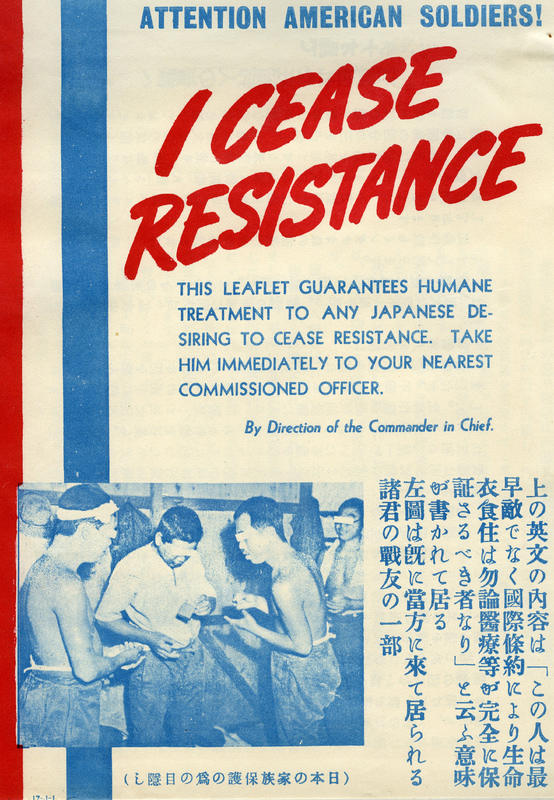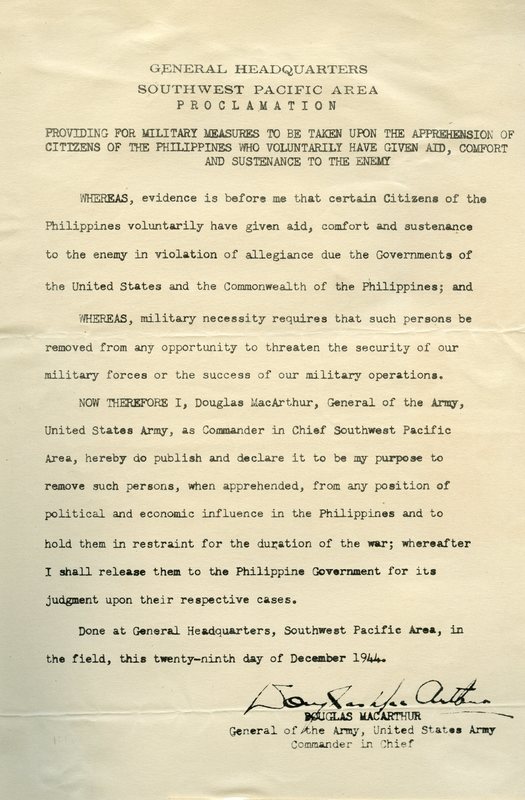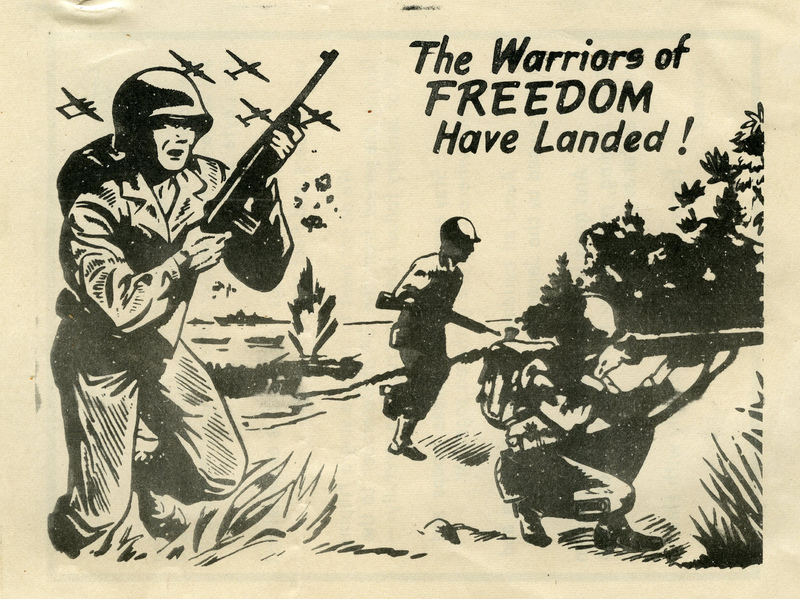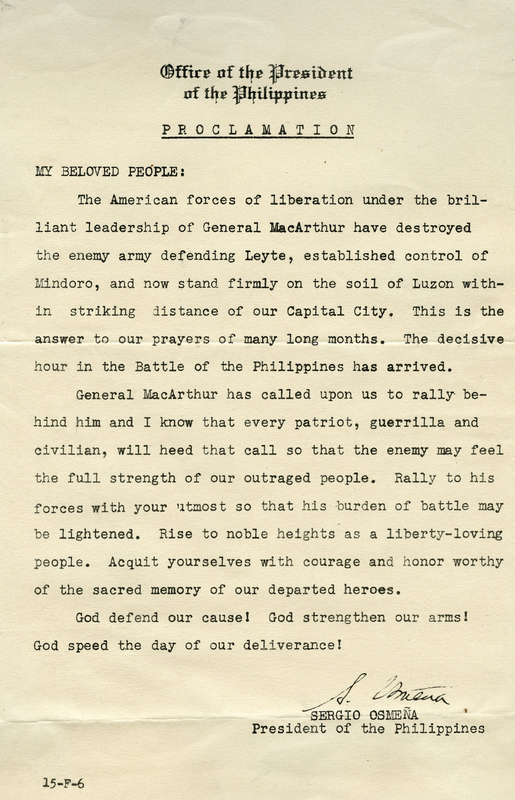WWII Propaganda Leaflets from the Baldwin Scrapbook
- Title
- WWII Propaganda Leaflets from the Baldwin Scrapbook
- Description
- The Psychological Warfare Branch of the United States Armed Forces was a military unit that created and distributed propaganda during the Second World War. The scrapbook contains approximately 200 pieces of their propaganda, mostly in Japanese, that were intended for distribution in the Philippines, Japan, and other nearby areas. Each item is accompanied by a typed translation into English. Pacific University Archives MS.70
Items
-
'Germany Capitulates' propaganda leafletA propaganda leaflet issued by the Allied Forces during World War II in anticipation of the German surrender in 1945. The leaflets were airdropped to Japanese troops and civilians everywhere, soon after the Germans surrendered in May, 1945. One side features an illustration of a German soldier with his hands in the air and a dark cloud stretching to Japan. The other side states that Germany has fallen, the war in Europe is over and Japan is the sole survivor without support. The intent of the leaflets were to lower Japanese morale. It is numbered '42 J 6'. It is accompanied by an official description and translation of the text into English. This is one item from a scrapbook of propaganda leaflets and related materials that was compiled by the Psychological Warfare Branch of the Allied Forces in the Southwest Pacific Area during World War II. The scrapbook belonged to Colonel Karl F. Baldwin of the United States Army, who helped establish the propaganda program. It contains approximately 200 pieces of propaganda, mostly in Japanese, that were intended for distribution in the Philippines, Japan, and other nearby areas.
-
'Who's Chasing Who' propaganda leafletA propaganda leaflet issued by the Allied Forces during World War II after the return of General Douglas MacArthur to the Philippine Islands in 1944. The leaflets were probably airdropped to Japanese troops on the Philippine Islands soon after General MacArthur landed in October, 1944. One side features an image of a map of the South Pacific with a red arrow indicating the American troops advancements. The arrow points directly at Tokyo. The other side states that General Yamashita says that he has been chasing General Douglas MacArthur all over the southern seas. The intent of the leaflet is to show Japanese troops the true picture of the war and to make Yamashita lose faith in his troops. The leaflet is numbered '41-J-6'. It is accompanied by an official description and translation of the text into English. This leaflet was included in a scrapbook of propaganda issued by the Psychological Warfare Branch which was collected for Colonel Karl F. Baldwin.
-
'Korean' leafletA propaganda leaflet issued by the Allied Forces during World War II after the return of General Douglas MacArthur in 1944. The leaflets were probably airdropped to Korean troops on the Philippine Islands soon after General MacArthur landed in October, 1944. It features a letter written by a captured Korean soldier addressed to his fellow comrades. His letter implores Korean troops fighting for Japan to recall their feelings about the Japanese. The intent of this leaflet was to induce the surrender of Korean troops. The leaflet is numbered '40 J 6'. It is accompanied by an official description and translation of the text into English. This is one item from a scrapbook of propaganda leaflets and related materials that was compiled by the Psychological Warfare Branch of the Allied Forces in the Southwest Pacific Area during World War II. The scrapbook belonged to Colonel Karl F. Baldwin of the United States Army, who helped establish the propaganda program. It contains approximately 200 pieces of propaganda, mostly in Japanese, that were intended for distribution in the Philippines, Japan, and other nearby areas.
-
'Bataan Appeal' leafletA propaganda leaflet issued by the Allied Forces during World War II after the return of General Douglas MacArthur in 1944. The leaflets were probably airdropped to Japanese troops on the Philippine Islands cut off on Bataan, soon after General MacArthur landed in October, 1944. One side features an image of a map showing American and Japanese positions on Bataan. The other side contains a statement about the preparedness of the Americans and that the Japanese troops have no means of escape. It explains how the Japanese troops can surrender and promises the fair treatment. The intent of this leaflet was to induce the surrender of Japanese troops by demoralizing them. The leaflet is numbered '39 J 6'. It is accompanied by an official description and translation of the text into English. This is one item from a scrapbook of propaganda leaflets and related materials that was compiled by the Psychological Warfare Branch of the Allied Forces in the Southwest Pacific Area during World War II. The scrapbook belonged to Colonel Karl F. Baldwin of the United States Army, who helped establish the propaganda program. It contains approximately 200 pieces of propaganda, mostly in Japanese, that were intended for distribution in the Philippines, Japan, and other nearby areas.
-
'Formosan Leaflet' flierA flier issued by the Allied Forces during World War II after General Douglas MacArthur returned to the Philippine Islands in 1944. It was probably airdropped to the citizens of Formosa, soon after General MacArthur landed in October, 1944. One side features an image of a man with American planes flying overhead, with the word 'Hope'. The other side states that the Americans would soon be coming to free the people of Formosa from their Japanese oppressors. The flier is numbered '1 H 6'. It is accompanied by an official description and translation of the text into English. This is one item from a scrapbook of propaganda leaflets and related materials that was compiled by the Psychological Warfare Branch of the Allied Forces in the Southwest Pacific Area during World War II. The scrapbook belonged to Colonel Karl F. Baldwin of the United States Army, who helped establish the propaganda program. It contains approximately 200 pieces of propaganda, mostly in Japanese, that were intended for distribution in the Philippines, Japan, and other nearby areas.
-
'Agoo-Pugo-Pongong' propaganda leafletA propaganda leaflet issued by the Allied Forces during World War II after the return of General Douglas MacArthur to the Philippine Islands in 1944. The leaflets were probably airdropped to Japanese troops on the Philippine Islands in the Agoo-Pugo-Pongong region, soon after General MacArthur landed in October, 1944. One side features an image of a map depicting how hopeless the Japanese situation was. The other side states that the best option for the Japanese troops is to surrender to the Americans. The intent of the leaflets were to dissuade the troops from retreating into the mountains and to induce their surrender instead. It is numbered '38 J 6'. The leaflet is accompanied by an official description and translation of the text into English. This is one item from a scrapbook of propaganda leaflets and related materials that was compiled by the Psychological Warfare Branch of the Allied Forces in the Southwest Pacific Area during World War II. The scrapbook belonged to Colonel Karl F. Baldwin of the United States Army, who helped establish the propaganda program. It contains approximately 200 pieces of propaganda, mostly in Japanese, that were intended for distribution in the Philippines, Japan, and other nearby areas.
-
'Aims' propaganda leafletA propaganda leaflet issued by the Allied Forces during World War II after the return of General Douglas MacArthur to the Philippine Islands in 1944. The leaflets were probably airdropped to Japanese troops on the Philippine Islands soon after General MacArthur landed in October, 1944. One side features an image of four generations of Japanese men. The other side states that the United States does not want to continue fighting, but desires peace. The leaflets were intended to establish the American aims and induce the surrender of Japanese troops. It is numbered '36 J 6'. The leaflet is accompanied by an official description and translation of the text into English. This is one item from a scrapbook of propaganda leaflets and related materials that was compiled by the Psychological Warfare Branch of the Allied Forces in the Southwest Pacific Area during World War II. The scrapbook belonged to Colonel Karl F. Baldwin of the United States Army, who helped establish the propaganda program. It contains approximately 200 pieces of propaganda, mostly in Japanese, that were intended for distribution in the Philippines, Japan, and other nearby areas.
-
'Two Roads of Thought' propaganda leafletA propaganda leaflet issued by the Allied Forces during World War II after General Douglas MacArthur returned to the Philippines in 1944. The leaflets were probably airdropped to Japanese troops on the Philippine Islands soon after General MacArthur landed in October, 1944. One side features an illustration of a Japanese soldier standing at a fork in the road. The other side asks the troops to think if they would rather return home to their family or die fighting. It contains instructions on how to surrender to American forces. The intent of the leaflets were to induce the surrender of Japanese troops by demoralizing them. It is numbered '35 J 6'. The leaflet is accompanied by an official description and translation of the text into English. This is one item from a scrapbook of propaganda leaflets and related materials that was compiled by the Psychological Warfare Branch of the Allied Forces in the Southwest Pacific Area during World War II. The scrapbook belonged to Colonel Karl F. Baldwin of the United States Army, who helped establish the propaganda program. It contains approximately 200 pieces of propaganda, mostly in Japanese, that were intended for distribution in the Philippines, Japan, and other nearby areas.
-
'Manilla Falls' propaganda leafletA propaganda leaflet issued by the Allied Forces during World War II during the Battle of Manila in 1945. The leaflets were probably airdropped to Japanese troops on the Philippine Islands in the Luzon region soon after the battle ended in March, 1945. One side features a map showing how close Manila is to other Japanese strongholds, highlighting the importance of the Americans taking control of Manila. The other side of the leaflet explains how important controlling Manila is to the war effort. The leaflets were printed before the Americans took control of Manila. It is numbered '33 J 6'. The leaflet is accompanied by an official description and translation of the text into English. This is one item from a scrapbook of propaganda leaflets and related materials that was compiled by the Psychological Warfare Branch of the Allied Forces in the Southwest Pacific Area during World War II. The scrapbook belonged to Colonel Karl F. Baldwin of the United States Army, who helped establish the propaganda program. It contains approximately 200 pieces of propaganda, mostly in Japanese, that were intended for distribution in the Philippines, Japan, and other nearby areas.
-
'Nostalgia Poems' propaganda leafletA propaganda leaflet issued by the Allied Forces during World War II after the return of General Douglas MacArthur to the Philippine Islands in 1944. The leaflets were airdropped to Japanese troops on the Philippine Islands soon after General MacArthur landed in October, 1944. One side depicts a kadomatsu or 'pine gates' that are representative of Japanese New Years tradition. The other side contains a New Years poem. It was meant to induce the surrender of Japanese troops by lowering morale. The leaflet let is numbered '32J6'. It is accompanied by an official description and translation of the text into English. This is one item from a scrapbook of propaganda leaflets and related materials that was compiled by the Psychological Warfare Branch of the Allied Forces in the Southwest Pacific Area during World War II. The scrapbook belonged to Colonel Karl F. Baldwin of the United States Army, who helped establish the propaganda program. It contains approximately 200 pieces of propaganda, mostly in Japanese, that were intended for distribution in the Philippines, Japan, and other nearby areas.
-
'Landing Instructions' flierA paper flier issued by the Allied Forces during World War II after General Douglas MacArthur returned to the Philippine Islands in 1944. It was airdropped to the Filipino citizens in the SW Luzon region, soon after General MacArthur landed in October, 1944. The flier gives instructions on how to assist the Americans in the liberation of the Philippine Islands. The flier is numbered '17 F 6'. This is one item from a scrapbook of propaganda leaflets and related materials that was compiled by the Psychological Warfare Branch of the Allied Forces in the Southwest Pacific Area during World War II. The scrapbook belonged to Colonel Karl F. Baldwin of the United States Army, who helped establish the propaganda program. It contains approximately 200 pieces of propaganda, mostly in Japanese, that were intended for distribution in the Philippines, Japan, and other nearby areas.
-
Bomb Warning for the Philippine Islands flierA paper flier issued by the Allied Forces during World War II after the return of General Douglas MacArthur to the Philippine Islands. It was probably airdropped to citizens on the Philippine Islands soon after General MacArthur landed in October, 1944. The intent of the flier was to warn people that the American planes were bombing and strafing the area. It is numbered '18 F 6'. This is one item from a scrapbook of propaganda leaflets and related materials that was compiled by the Psychological Warfare Branch of the Allied Forces in the Southwest Pacific Area during World War II. The scrapbook belonged to Colonel Karl F. Baldwin of the United States Army, who helped establish the propaganda program. It contains approximately 200 pieces of propaganda, mostly in Japanese, that were intended for distribution in the Philippines, Japan, and other nearby areas.
-
'No Escape Route' propaganda leafletA propaganda leaflet issued by the Allied Forces during World War II after the return of General Douglas MacArthur to the Philippine Islands in 1944. The leaflets were probably airdropped to Japanese troops on the Philippine Islands near Manila, soon after General MacArthur landed in October, 1944. It features a message about the treatment of those troops that surrender to Filipino Guerrilla fighters or to American troops. The leaflets were meant to induce the surrender of Japanese troops. It is numbered '5-J-21'. The leaflet is accompanied by an official description and translation of the text into English. This is one item from a scrapbook of propaganda leaflets and related materials that was compiled by the Psychological Warfare Branch of the Allied Forces in the Southwest Pacific Area during World War II. The scrapbook belonged to Colonel Karl F. Baldwin of the United States Army, who helped establish the propaganda program. It contains approximately 200 pieces of propaganda, mostly in Japanese, that were intended for distribution in the Philippines, Japan, and other nearby areas.
-
'Crime Does Not Pay' Japanese ComicA propaganda comic issued by the Japanese during World War II. The comic depicts a man that wishes to make money by helping the Filipino Guerrilla fighters. It was intended to warn Filipinos away from helping Guerrilla fighters. This is one item from a scrapbook of propaganda leaflets and related materials that was compiled by the Psychological Warfare Branch of the Allied Forces in the Southwest Pacific Area during World War II. The scrapbook belonged to Colonel Karl F. Baldwin of the United States Army, who helped establish the propaganda program. It contains approximately 200 pieces of propaganda, mostly in Japanese, that were intended for distribution in the Philippines, Japan, and other nearby areas.
-
'The Way to Safety, No. 5' propaganda leafletA propaganda leaflet issued by the Allied Forces during World War II after the return of General Douglas MacArthur to the Philippine Islands in 1944. The leaflets were airdropped to Japanese troops on the Philippine Islands soon after General MacArthur landed in October, 1944. It invokes the image of General Nogi that was ordered not to commit suicide during the Russo-Japanese war by the Emperor because he remained useful to Japan. The leaflet gives instructions to Japanese troops on how to surrender to the Americans and guarantees they will be treated humanely. The intent of this leaflet was to induce the surrender of Japanese troops. It is numbered '5J3'. The leaflet is accompanied by an official description and translation of the text into English. This is one item from a scrapbook of propaganda leaflets and related materials that was compiled by the Psychological Warfare Branch of the Allied Forces in the Southwest Pacific Area during World War II. The scrapbook belonged to Colonel Karl F. Baldwin of the United States Army, who helped establish the propaganda program. It contains approximately 200 pieces of propaganda, mostly in Japanese, that were intended for distribution in the Philippines, Japan, and other nearby areas.
-
'The Way to Safety, No. 4' propaganda leafletA propaganda leaflet issued by the Allied Forces during World War II after the return of General Douglas MacArthur to the Philippine Islands in 1944. The leaflets were probably airdropped to the Japanese troops, soon after General MacArthur landed in October, 1944. It features a message from a Japanese prisoner of war addressed to his fellow Japanese troops. The text describes the humane treatment that he is receiving and urges his comrades to surrender as well. The back of the leaflet give instructions to Japanese troops on how to surrender to Americans. The intent of this leaflet is to induce the surrender of Japanese troops by demonstrating the humane treatment troops will recieve from the Allied Forces. It is numbered '4J3'. The leaflet is accompanied by an official description and translation of the text into English. This is one item from a scrapbook of propaganda leaflets and related materials that was compiled by the Psychological Warfare Branch of the Allied Forces in the Southwest Pacific Area during World War II. The scrapbook belonged to Colonel Karl F. Baldwin of the United States Army, who helped establish the propaganda program. It contains approximately 200 pieces of propaganda, mostly in Japanese, that were intended for distribution in the Philippines, Japan, and other nearby areas.
-
'The Way to Safety, No. 3' propaganda leafletA propaganda leaflet issued by the Allied Forces during World War II after the return of General Douglas MacArthur to the Philippine Islands in 1944. It was probably airdropped to Japanese troops on the Philippine Islands soon after General MacArthur landed in October, 1944. The leaflet is a message from a Japanese officer that surrendered to the Allied Forces. It instructs his fellow officers to surrender to the Americans, as it is the only option for them. The leaflet gives the instructions for surrendering on the back side. It was intended to induce the surrender of Japanese troops by demoralizing them. It is numbered '3J3'. The leaflet is accompanied by an official description and translation of the text into English. This is one item from a scrapbook of propaganda leaflets and related materials that was compiled by the Psychological Warfare Branch of the Allied Forces in the Southwest Pacific Area during World War II. The scrapbook belonged to Colonel Karl F. Baldwin of the United States Army, who helped establish the propaganda program. It contains approximately 200 pieces of propaganda, mostly in Japanese, that were intended for distribution in the Philippines, Japan, and other nearby areas.
-
'Officers and NCOs of the Fuji Heidan' propaganda leafletA propaganda leaflet issued by the Allied Forces during World War II after the battle for Iwo Jima in 1945. It was probably airdropped to Japanese officers and NCOs on the Philippine Islands soon after the battle of Iwo Jima ended in March, 1945. The leaflet addresses the responsibility the officers and NCOs have with regards to the livelihood of their troops. It gives instructions on how to surrender to the Allied Forces and promises humane treatment of prisoners of war. The leaflets were intended to induce the surrender of Japanese troops. It is numbered '1-J-3'. The leaflet is accompanied by an official description and translation of the text into English. This is one item from a scrapbook of propaganda leaflets and related materials that was compiled by the Psychological Warfare Branch of the Allied Forces in the Southwest Pacific Area during World War II. The scrapbook belonged to Colonel Karl F. Baldwin of the United States Army, who helped establish the propaganda program. It contains approximately 200 pieces of propaganda, mostly in Japanese, that were intended for distribution in the Philippines, Japan, and other nearby areas..
-
'Order to Kill J. Sick and Wounded' propaganda leafletA propaganda leaflet issued by the Allied Forces during World War II after the return of General Douglas MacArthur to the Philippine Islands in 1944. It was probably airdropped to Japanese troops on the Philippine Islands in the Luzon area, soon after General MacArthur landed in October, 1944. One side features the words 'I Cease Resistance' with instructions for Japanese troops to present the leaflet to any American soldier for guaranteed humane treatment. This side of the leaflet is numbered '17-J-1'. The back side of the leaflet contains a message for Japanese troops in Luzon. The text states that the Japanese Army has received ordered to dispose of any sick or wounded troops. This side of the leaflet is numbered '7-J-11'.It was intended to induce the surrender of Japanese troops. The leaflet is accompanied by an official description and translation of the text into English. This is one item from a scrapbook of propaganda leaflets and related materials that was compiled by the Psychological Warfare Branch of the Allied Forces in the Southwest Pacific Area during World War II. The scrapbook belonged to Colonel Karl F. Baldwin of the United States Army, who helped establish the propaganda program. It contains approximately 200 pieces of propaganda, mostly in Japanese, that were intended for distribution in the Philippines, Japan, and other nearby areas.
-
'Army Protects Navy' propaganda leafletA propaganda leaflet issued by the Allied Forces during World War II after the return of General Douglas MacArthur to the Philippine Islands in 1944. It was probably airdropped to Japanese troops on the Philippine Islands soon after General MacArthur landed in October, 1944. One side features the words 'I Cease Resistance' with instructions for Japanese troops to present the leaflet to any American soldier for guaranteed humane treatment. The back of the leaflet addresses the Japanese army in the Luzon mountains that have been abandoned. It explains that no one is going to rescue them and their only way out is to surrender. This leaflet was intended to induce the surrender of Japanese troops by demoralizing them. It is numbered '1-J-11'. The leaflet is accompanied by an official description and translation of the text into English. This is one item from a scrapbook of propaganda leaflets and related materials that was compiled by the Psychological Warfare Branch of the Allied Forces in the Southwest Pacific Area during World War II. The scrapbook belonged to Colonel Karl F. Baldwin of the United States Army, who helped establish the propaganda program. It contains approximately 200 pieces of propaganda, mostly in Japanese, that were intended for distribution in the Philippines, Japan, and other nearby areas.
-
'To Inducted Japanese on Mindanao' propaganda leafletA propaganda leaflet issued by the Allied Forces during World War II after the return of General Douglas MacArthur to the Philippine Islands in 1944. It was probably airdropped to Japanese troops on the Philippine Islands soon after General MacArthur landed in October, 1944. One side features the words 'I Cease Resistance' with instructions for Japanese troops to present the leaflet to any American soldier for guaranteed humane treatment. The other side of the leaflet implores Japanese residents living in Mindanao to hand over their arms and avoid joining the fight against the Allied Forces. It stresses the folly of the Japanese Militarists and assured victory of the Americans. The leaflet is numbered '3-J-10'. It is accompanied by an official description and translation of the text into English. This is one item from a scrapbook of propaganda leaflets and related materials that was compiled by the Psychological Warfare Branch of the Allied Forces in the Southwest Pacific Area during World War II. The scrapbook belonged to Colonel Karl F. Baldwin of the United States Army, who helped establish the propaganda program. It contains approximately 200 pieces of propaganda, mostly in Japanese, that were intended for distribution in the Philippines, Japan, and other nearby areas.
-
General Douglas MacArthur Proclamation leafletA leaflet issued by the Allied Forces during World War II after the return of General Douglas MacArthur to the Philippine Islands in 1944. The leaflets were probably airdropped to the citizens of the Philippine Islands soon after General MacArthur landed in October, 1944. It was a proclamation by General MacArthur of the removal of any persons of influence in political or economic positions if they collaborate with the enemy. This is one item from a scrapbook of propaganda leaflets and related materials that was compiled by the Psychological Warfare Branch of the Allied Forces in the Southwest Pacific Area during World War II. The scrapbook belonged to Colonel Karl F. Baldwin of the United States Army, who helped establish the propaganda program. It contains approximately 200 pieces of propaganda, mostly in Japanese, that were intended for distribution in the Philippines, Japan, and other nearby areas.
-
'The Warriors of Freedom Have Landed' flierA flier issued by the Allied Forces during World War II after the return of General Douglas MacArthur to the Philippine Islands in 1944. The flier was probably airdropped to the citizens of the Philippine Islands soon after General MacArthur landed in October, 1944. It features instructions to stay away from certain areas between the dates December 15th and January 8th. The instructions state to leave the beaches and head inland as soon as Allied Forces appear on the beaches. The flier is numbered '7F6'. This is one item from a scrapbook of propaganda leaflets and related materials that was compiled by the Psychological Warfare Branch of the Allied Forces in the Southwest Pacific Area during World War II. The scrapbook belonged to Colonel Karl F. Baldwin of the United States Army, who helped establish the propaganda program. It contains approximately 200 pieces of propaganda, mostly in Japanese, that were intended for distribution in the Philippines, Japan, and other nearby areas.
-
President Sergio Osmena Proclamation flierA flier issued by the Allied Forces during World War II after the return of General Douglas MacArthur and President Osmena to the Philippine Islands in 1944. The flier was probably airdropped to the citizens of the Philippine Islands soon after General MacArthur and President Osmena landed in October, 1944. It is a proclamation written by President Sergio Osmena urging the Filipino citizens to rally their support for General Douglas MacArthur and the American troops. The flier is numbered '15-F-6'. This is one item from a scrapbook of propaganda leaflets and related materials that was compiled by the Psychological Warfare Branch of the Allied Forces in the Southwest Pacific Area during World War II. The scrapbook belonged to Colonel Karl F. Baldwin of the United States Army, who helped establish the propaganda program. It contains approximately 200 pieces of propaganda, mostly in Japanese, that were intended for distribution in the Philippines, Japan, and other nearby areas.

